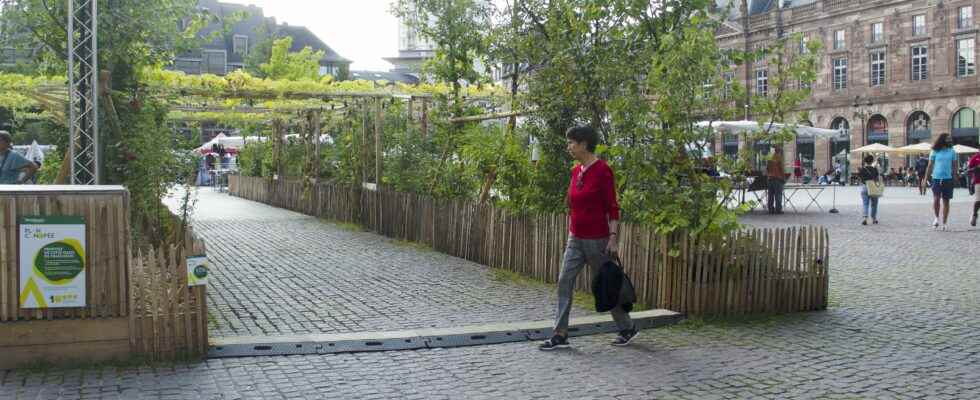On July 18, around sixty French municipalities experienced absolute temperature records: 38.2°C in Limoges, 39.7°C in Saint-Brieuc, 40.1°C in Caen, 42°C in Nantes… And it will take some getting used to. Heat waves will intensify due to global warming, according to the Intergovernmental Panel on Climate Change (IPCC). Problem: Cities are particularly vulnerable due to a phenomenon that specialists call urban heat islands (UHIs).
“The difference in air temperature can exceed 5°C between city districts and the surrounding countryside”, explains Elodie Briche, research and development coordinator around sustainable urban planning within the Ecological Transition Agency ( Ademe). In question ? The mineral, impermeable and dark nature of the cities, which store heat during the day and then release it in the evening, amplifying the phenomenon of “tropical night” when the thermometer does not drop below 20°C until the morning. A phenomenon further reinforced by road traffic and air conditioning, which directly heat the air. Beyond the comfort of the inhabitants, this is a real public health issue. According to a study (Cadot, 2006), excess mortality during the 2003 heat wave amounted to 141% in Paris… compared to “only” 40% in rural areas.
Create oases in the city
What solutions can municipalities put in place to avoid turning into an oven? Last year, Ademe published a practical guide entitled Refreshing cities, listing four types of solutions: “green”, “blue”, “grey” and “soft”. The first two are based on the contribution of nature and involve plants (parks, green roofs or walls, lawn, etc.) and water. Planting hardwoods to create oases in the city seems obvious. Beyond shading, they provide freshness thanks to the evapotranspiration mechanism. “A 25-year-old tree can have the same effect on a day as four air conditioners”, illustrates Laurent Bizot, president of the National Union of Landscape Companies (Unep).
In Strasbourg, the new ecological municipality adopted in 2020 a “Canopy plan”. Objective: plant 10,000 new trees by 2030, in order to create a green expanse occupying 30% of the area of the territory against 26% currently. “We encourage the population to suggest places to us via our website”, specifies Suzanne Brolly, deputy mayor in charge of the resilient city. A strategy rewarded with the first prize in the EcoActions Trophies awarded by the Eco-Maires association. And the government announced during the summer a plan for “renaturation of cities” of 500 million euros.
The concept of “sponge city”
Be careful, however, not to fall into a greening of the facade! “When we install living things, the question inevitably arises of its maintenance, and therefore of the associated budget”, recalls Loéna Trouvé, project manager at the Center for Studies and Expertise on Risks, the Environment, Mobility and development (Cerema). According to an online survey by Ademe, 42% of the 600 communities questioned report unmaintained vegetation on their territory. And 16% of them have even… repaved them instead, rather than leaving them abandoned. The problem often comes from the cost of indigenous (and not exotic) species to plant, or from a lack of knowledge about them. “With global warming, we see plants in the Paris region that only grew in the Mediterranean about thirty years ago,” says Laurent Bizot. The implicit issue? Water management for irrigation, at a time when restrictions will become more frequent. “We don’t plant a tree like a bench: nature works in an ecosystem”, recalls Cécile Vo Van, nature project director in the city at Cerema.
No more parking lots or large asphalt squares that reject rain precipitation; place to the concept of “sponge city”. “We have long considered water to be waste even though it has great refreshing power”, insists Cécile Vo Van. To take advantage of these natural fridges, municipalities are now redeveloping their river banks, when they are not completely rediscovering their waterways abused by galloping urbanization, such as the Aygalades stream, north of Marseille. However, beware, here again, of false good ideas in this area. “Public foggers represent effective responses, but not at all sustainable”, warns Elodie Briche. For each action, it is therefore necessary to measure both the advantages, direct or indirect (biodiversity or carbon sequestration, for example), and the disadvantages (cost, consumption of resources, etc.).
The “grey” solutions consist of playing with materials or urban infrastructures to promote the circulation of winds, shade or the reflection of the sun. Like clear coatings that limit the absorption of sunlight. “At the scale of a city, the cooling effect is noticeable, but at that of the individual, everything depends on the context”, warns Elodie Briche. In fact, a large square can turn into a dazzling surface for pedestrians, while in the narrow streets of the villages of the Greek islands, comfort is immediate. Finally, “soft” remedies focus on urban human practices and activities. The range is wide: modification of working hours; road traffic regulation; limitation of air conditioning; awareness of carbon-free mobility… “All these ideas must be combined, by mapping the heat islands beforehand in order to know the vulnerabilities of each territory”, recommends Loéna Trouvou. Laurent Bizot, however, brings a major nuance: “A city is 80% private areas. The effort must therefore be shared between elected officials, business leaders, donors and the French themselves.” A collective awareness to which Cécile Vo Van fully subscribes: “Each plot can contribute to cooling.”
